Owner???s Operator and Maintenance Manual
Portable Patient Lift and
Sling
DEALER: This manual MUST be given to the user of the patient lift.
USER: BEFORE using this patient lift, read this manual and save for future reference.
For more information regarding Invacare products, parts, and services, please visit www.invacare.com
� WARNING
A QUALIFIED TECHNICIAN MUST PERFORM THE INITIAL SET UP
OF THIS LIFT. ALSO, A QUALIFIED TECHNICIAN MUST PERFORM
ALL PROCEDURES IN THE SERVICE MANUAL.
DEALERS AND QUALIFIED TECHNICIANS: DO NOT SERVICE OR
OPERATE THIS EQUIPMENT WITHOUT FIRST READING AND
UNDERSTANDING THE OWNER???S OPERATOR AND
MAINTENANCE MANUAL, THE SERVICE MANUAL (IF
APPLICABLE) AND THE SEATING SYSTEM???S MANUAL (IF
APPLICABLE). IF YOU ARE UNABLE TO UNDERSTAND THE
WARNINGS, CAUTIONS AND INSTRUCTIONS, CONTACT
INVACARE TECHNICAL SUPPORT BEFORE ATTEMPTING TO
SERVICE OR OPERATE THIS EQUIPMENT - OTHERWISE, INJURY
OR DAMAGE MAY RESULT.
NOTE: Updated versions of this manual are available on www.invacare.com.
The benefits of registering:
1.Safeguard your investment.
2.Ensure long term maintenance and servicing of your purchase.
3.Receive updates with product information, maintenance tips, and industry news.
4.Invacare can contact you or your provider, if servicing is needed on your product.
5.It will enable Invacare to improve product designs based on your input and needs.
Register ONLINE at www.invacare.com - or -
Complete and mail the form on the next page
Any registration information you submit will be used by Invacare Corporation only, and protected as required by applicable laws and regulations.
Fold
here
Cut Along Line
Fold
here
Invacare Product Registration Form
Please Seal with
Tape Before Mailing
LABEL LOCATION
LABEL LOCATION
Models 9805 and 9805P
 WARNING
WARNING
WEIGHT CAPACITY is 450 lbs. The INVACARE Patient Lift is NOT a transport device. Moving a person suspended in a sling over ANY distance is NOT R E C O M M E N D E D .
DO NOT roll casterbase over deep carpet, raised carpet bindings, door frames or any uneven surfaces that may cause the Patient Lift to tip over.
DO NOT lock the casters of the Patient Lift when lifting an individual. Casters MUST be left unlocked to allow P a t i e n t L i f t t o s t a b i l i z e during lifting procedures.
U S E O N L Y g e n u i n e INVACARE SLINGS and LIFT
ACCESSORIES.
Refer to Owner's Manual for periodic Maintenance Procedures.
NOTICE
Upon receipt of the patient lift, the end user shoud request an updated version of the owner's manual for proper operation and safety procedures.
Customer Service: 1-800-333-6900
1059597
SPECIAL NOTES
SPECIAL NOTES
Signal words are used in this manual and apply to hazards or unsafe practices which could result in personal injury or property damage. Refer to the following table for definitions of the signal words.
NOTICE
THE INFORMATION CONTAINED IN THIS DOCUMENT IS SUBJECT TO
CHANGE WITHOUT NOTICE.
MAINTENANCE
Maintenance MUST be performed only by qualified personnel.
NOTES highlight procedures and contain information which assist the operator in understanding the information contained in this manual.
� WARNING
Invacare products are specifically designed and manufactured for use in conjunction with Invacare accessories. Accessories designed by other manufacturers have not been tested by Invacare and are not recommended for use with Invacare products.
TYPICAL PRODUCT PARAMETERS
TYPICAL PRODUCT PARAMETERS

SECTION 1???GENERAL GUIDELINES
SECTION 1???GENERAL GUIDELINES
� WARNING
SECTION 1 - GENERAL GUIDELINES contains important information for the safe operation and use of this product. DO NOT use this product or any available optional equipment without first completely reading and understanding these instructions and any additional instructional material such as Owner???s Manuals, Service Manuals or Instruction Sheets supplied with this product or optional equipment. If you are unable to understand the Warnings, Cautions or Instructions, contact a healthcare professional, dealer or technical personnel before attempting to use this equipment - otherwise, injury or damage may occur.
Check all parts for shipping damage before using. In case of damage, DO NOT use the equipment. Contact the Dealer for further instructions.
The Invacare patient lift is not a transport device. It is intended to transfer an individual from one resting surface to another (such as a bed to a wheelchair). Moving a person suspended in a sling over any distance is not recommended.
DO NOT attempt any transfer without approval of the patient???s physician, nurse or medical assistant. Thoroughly read the instructions in this Owner???s Manual, observe a trained team of experts perform the lifting procedures and then perform the entire lift procedure several times with proper supervision and a capable individual acting as a patient.
Use common sense while operating lifts. Special care MUST be taken with people with disabilities who cannot cooperate while being lifted.
Invacare slings and patient lift accessories are specifically designed to be used in conjunction with Invacare patient lifts. Slings and accessories designed by other manufacturers are not to be utilized as a component of Invacare???s patient lift system.
Assembling the Lift
DO NOT overtighten mounting hardware. This will damage mounting brackets.
Operating the Lift
Although Invacare recommends that two assistants be used for all lifting preparation, transferring from and transferring to procedures, our equipment will permit proper operation by one assistant. The use of one assistant is based on the evaluation of the healthcare professional for each individual case.
DO NOT exceed maximum weight limitation of the patient lift. The weight limitation for the 9805 and the 9805P lifts is 450 lbs.

SECTION 1???GENERAL GUIDELINES
If the patient lift is exposed to extreme temperature (above 100??F or below 32??F), high humidity and/or becomes wet, prior to use, ensure handgrips do not twist on patient lift handle - otherwise damage or injury may occur.
Using the Sling
Use an Invacare approved sling that is recommended by the individual???s doctor, nurse or medical assistant for the comfort and safety of the individual being lifted.
DO NOT use any kind of plastic back incontinence pad or seating cushion between patient and sling material that may cause the patient to slide out of the sling during transfer.
After each laundering (in accordance with instructions on the sling), inspect sling(s) for wear, tears, and loose stitching.
Bleached, torn, cut, frayed, or broken slings are unsafe and could result in injury. Discard
IMMEDIATELY.
DO NOT alter slings.
Be sure to check the sling attachments each time the sling is removed and replaced to ensure that it is properly attached before the patient is removed from a stationary object (bed, chair or commode).
If the patient is in a wheelchair, secure the wheel locks in place to prevent the chair from moving forwards or backwards.
When connecting slings equipped with color coded straps to the patient lift, the shortest of the straps MUST be at the back of patient for support. Using longer straps will leave little or no support for patient??s back. The loops of the sling are color coded and can be used to place patient in various positions. The colors make it easy to connect both sides of the sling equally. Make sure that there is sufficient head support when lifting a patient.
Lifting the Patient
When using an adjustable base lift, the legs MUST be in the maximum Opened/Locked position before lifting the patient.
When the sling is elevated a few inches off the surface of the bed and before moving the patient, check again to make sure that the sling is properly connected to the hooks of the swivel bar. If any attachments are not properly in place, lower the patient back onto the stationary surface and correct this problem - otherwise, injury or damage may occur.
Adjustments for safety and comfort should be made before moving the patient. Patient??s arms should be inside of the straps.
Invacare slings are made specifically for use with Invacare Patient Lifts. For the safety of the patient, DO NOT intermix slings and patient lifts of different manufacturers.

SECTION 1???GENERAL GUIDELINES
Before transferring a patient from a stationary object (wheelchair, commode or bed), slightly raise the patient off the stationary object and check that all sling attachments are secure. If any attachment is not correct, lower the patient and correct the problem, then raise the patient and check again.
During transfer, with patient suspended in a sling attached to the lift, DO NOT roll caster base over objects such as carpet, raised carpet bindings, door frames, or any uneven surfaces or obstacles that would create an imbalance of the patient lift and could cause the patient lift to tip over. Use steering handle on the mast at all times to push or pull the patient lift.
Transferring the Patient
When elevated a few inches off the surface of the stationary object (wheelchair, commode, or bed) and before moving the patient, check again to make sure that the sling is properly connected to the hooks of the swivel bar. If any attachments are not properly in place, lower the patient back onto the commode chair or the standard commode and correct this problem.
Wheelchair wheel locks MUST be in a locked position before lowering the patient into the wheelchair for transport.
Before transferring, check that the wheelchair weight capacity can withstand the patient??s weight.
Be sure to check the sling attachments each time the sling is removed and replaced, to ensure that it is properly attached before the patient is removed from the bed or chair.
Mast pivot under the rubber boot must be tight to ensure safe use of the patient lift. Bolt MUST be checked at least every six months in conjunction with periodic maintenance.
Performing Maintenance
The pump is sealed at the factory. DO NOT attempt to open the pump or obtain local service as this will void the warranty and might result in damage. Consult your dealer or write Invacare for further information.
After the first year of use, the hooks of the swivel bar and the mounting brackets of the boom should be inspected every three months to determine the extent of wear. If these parts become worn, replace them IMMEDIATELY.
Casters and axle bolts require inspections every six months to check for tightness and wear.
After the first twelve months of operation, inspect the swivel bar and the eye of the boom (to which it attaches) for wear. If the metal is worn, the parts MUST be replaced. Make this inspection every six months thereafter.
Regular maintenance of patient lifts and accessories is necessary to assure proper operation.
DO NOT overtighten mounting hardware. This will damage mounting brackets.
SECTION 2???FEATURES
SECTION 2???FEATURES
Hydraulic Lifts
NOTE: For this procedure, refer to FIGURE 2.1.
Hydraulic pump suggested operating limit is 450 lbs.
Masts are interchangeable with bases. Lock together. Masts can be separated for storage.
Operation optimizes lift capabilities. The lift requires less physical effort for raising patient.
Patient Slings
� WARNING
Use a sling that is recommended by the individual???s doctor, nurse or medical assis- tant for the comfort and safety of the individual being lifted.
Patient slings work in conjunction with lifts to support the patient during lifting and transferring procedures.
Slings attach to the lift by using either sewn-in loop straps, chains or adjustable straps. Slings are adjustable. They are interchangeable with any Invacare patient lift.
Each sling offers reinforcing at each hook-on point to ensure patient safety.
Each sling is constructed of durable materials which resist deterioration from exposure to moisture or laundering.
SECTION 2???FEATURES
Invacare products are specifically designed and manufactured for use in conjunction with Invacare accessories. Accessories designed by other manufacturers have not been tested by Invacare and are not recommended for use with Invacare products.
Model Nos. 9042, 9043, 9046 and 9047 Slings
The one-piece contour sling can be used on heavy or light patients. Slings support the patient from shoulders to the knees. Slings are used for weighing, transferring or to simplify the use of bathroom facilities.
FIGURE 2.2 Patient Slings
SECTION 3???HANDLING
SECTION 3???HANDLING
Shipping and Transportation Instructions
NOTE: For this procedure, refer to FIGURE 3.1.
NOTE: If the patient lift is to be reshipped by common carrier, it should be packed in the same carton. Extra cartons are available from Invacare.
Unpacking
1.Check for any obvious damage to the carton or its contents. If damage is evident, notify Carrier/Invacare Dealer.
2.Remove all loose packing from the carton.
3.Carefully remove all the components from the carton.
NOTE: Unless the patient lift is to be used immediately, retain boxes, containers and packing material for use in storing until use of the patient lift is required.
Inspection
1.Examine exterior of the patient lift for nicks, dents, scratches or damages. Inspect all components.
Storage
1.Store the repackaged patient lift in a dry area.
2.DO NOT place other objects on top of the repackaged patient lift.
Screw Lift
(Ref.)
See
Detail ???A???
 Angle Swivel Bar
Angle Swivel Bar
Apply stretch wrap 5 to 6 times around the mast
Mast with pump  (Ref.)
(Ref.)
Swivel Bar
(Ref.)
 Tape Hex Key Here
Tape Hex Key Here
Tape (Ref.)
Tape (Ref.) Tape Hex
Key Here
SECTION 4???ASSEMBLY
SECTION 4???ASSEMBLY
Assembly of the Patient Lift
� WARNING
Use only Invacare parts in the assembly of this lift. The base legs, the mast, boom, pump assembly and the swivel bar are manufactured to specifications that assure correct alignment of all parts for safe functional operation.
CAUTION
DO NOT run the lift until it is fully assembled.
Follow the assembly instrudctions in the Owner???s Manual for proper assembly of this lift. Failure to do so could result in damage to the push handle of the lift, render- ing it inoperative.
NOTE: For this procedure, refer to FIGURE 4.1 and FIGURE 4.2.
Base, Mast and Boom Assembly
1.Unpack the components from the shipping cartons.
2.Remove the locking screw from the bottom of the base.
NOTE: The bottom of the mast assembly will have a notch.
3.Match the notch at the bottom of the mast assembly with the tabs inside the socket of the base assembly.
4.Insert the mast assembly into the socket and onto the tabs.
5.Turn the mast assembly to make sure that the notch is locked on the tabs of the socket.
NOTE: If the mast does not turn, the mast is centered and locked in place.
6.Insert the locking screw into the bottom of the base and securely tighten.
� WARNING
The mast may be removed from the base for storage or transporting. Each time the mast is removed and returned to the socket of the base, the mast MUST be locked into the socket of the base assembly.

SECTION 4???ASSEMBLY
7.Remove the bolt and locknut from the top of the mounting bracket of the mast assembly.
8.Align the holes of the boom assembly and mast assembly mounting bracket. Insert the bolt completely through the holes of the mast assembly mounting bracket and the boom assembly.
NOTE: Be sure that the bolt is completely through the holes of the mast assembly mounting bracket and boom assembly, and they are not riding on the shoulder of the bolt.
CAUTION
The boom and mast, when assembled, MUST pivot easily.
9. Tighten the bolt and nut using the Allen wrench provided and an adjustable wrench.
NOTE: The nut and bolt can be tightened completely and the boom assembly will pivot easily if the mounting hardware is aligned properly when the boom assembly is secured to the mast. To check for correct alignment of the hardware, use the Allen wrench provided and turn the bolt by hand (it should rotate without a lot of force being applied). If excessive force is necessary, the bolt is NOT aligned properly. Disassemble and repeat assembly procedures until proper alignment is obtained.
10.To check for tightness of nut and bolt:
A.Raise the boom assembly.
B.Push the control handle away from the pump assembly.
C.If the boom assembly pivots easily, then the nut and bolt are not too tight.
D.If the boom assembly does not pivot easily or does not pivot at all, then the nut and bolt are not aligned properly.
Boom Assembly
FIGURE 4.2 Assembly of the Patient Lift - Base, Mast and Boom Assembly
Base Shifter Handle Assembly
NOTE: For this procedure, refer to FIGURE 4.3.
1.Insert the base shifter handle into the cam lock assembly at the back of the base.
2.Align the holes of the shifter handle and cam lock assembly.
3.Tighten the thumbscrew to secure the shifter handle in place.
NOTE: This should prevent the base shifter handle from being removed.
Swivel Bar Attachment with Mounting Bracket
NOTE: For this procedure, refer to FIGURE 4.4.
1.Push the pin and washers up through the swivel bar pad.
2.Line-up hole in pin with mounting bracket holes and secure with shoulder screw and nut provided.
NOTE: The swivel bar has hooks on both ends to accept the hardware used to attach the sling that supports the patient during lift. The swivel bar pad should remain in place during normal use.
NOTE:MakesurePinandWashersarecompletely pushed up through the Swivel Bar Pad.
Swivel Bar Pad
FIGURE 4.4 Swivel Bar Attachment with Mounting Bracket

SECTION 5???ONE-PIECE CONTOUR SLINGS
SECTION 5???ONE-PIECE CONTOUR
SLINGS
Slings Using Chains, O-rings and D-rings
� WARNING
Invacare slings are designed specifically for use with Invacare Patient Lifts and made to support the patient during lift and transfer procedures. Slings attach to the lift with either straps or chains (interchangeable). The slings are reinforced at all points of attachment for safety. The fabrics used in these slings are of very durable materi- als that resist deterioration from exposure to moisture and laundering. This design will accommodate patients of heavy or light weight with support from the shoulders to the knees. The contour shape provides comfort during the lift by avoiding the bulk of excess material between the back and seat sections.
Fabric
The fabric has a smooth inner side. The outer side has binding tape around the pocket.
NOTE: Always place the sling under the patient with the smooth side next to the body.
Sling fabrics are offered in a choice of two materials. Canvas fabric is very durable for use and laundering and is preshrunk and dyed a BLUE color.
NOTE: Laundering should always be done with dark colors.
Open mesh nylon fabric is an exceptional material that provides safety and comfort for the patient. The open mesh weave of the fabric is dyed BLUE, preshrunk, and durable for use and laundering. It provides considerable traction to resist slipping and sliding during use.
Body
Slings may be ordered at the time of purchase with a commode opening in the seat section for use over a commode or a commode chair.
Each sling includes four metal support bars that have a hole at the center to attach the S-hook.
When shipped from the factory, these reinforcing metal support bars are enclosed in the sling pocket with the hole exposed.

SECTION 5???ONE-PIECE CONTOUR SLINGS
Positioning the Contour Sling
NOTE: For this procedure, refer to FIGURE 5.1.
1.Position the patient in the center of the bed and laying flat on his/her back.
2.Fold the sling in half (length-wise) and place the fabric sections of the sling beside the patient.
NOTE: The sling french seams (uneven surface) will be against the bed surface and facing the assistant when folded. The opposite side of the fabric is smooth. After the sling is positioned for lifting purposes, the smooth side will be next to the patient.
NOTE: The top edge of the sling fabric (nearest to the patient???s head) should be slightly above the armpit level of the patient.
NOTE: The bottom edge of the sling fabric should then be a few inches above the back of the patient???s knee.
3.With both assistants holding the patient, push the folded sling under the patient without rolling him/her over.
Center of Bed
Top Edge
 of Sling
of Sling
French Seams (Facing the  assistant and Bed Surface)
assistant and Bed Surface)
Bottom Edge
of Sling
FIGURE 5.1 Positioning the Contour Sling

SECTION 5???ONE-PIECE CONTOUR SLINGS
Positioning the Patient on the Sling
NOTE: For this procedure, refer to FIGURE 5.1 and FIGURE 5.2.
NOTE: Use the following method to easily move the patient and avoid strain to yourself.
1.If the patient is to roll to their left-side, then elevate the patient???s right knee until the right foot is flat on the bed (Detail ???B??? of FIGURE 5.1).
NOTE: Invacare recommends that two assistants (one on each side of the bed) be used when positioning the patient in a sling.
2.With an assistant on each side of the bed and up against the mattress, the assistantassistant on the left-hand side of the bed will position his/her right-hand on the elevated knee and his/her left-hand under the patient???s right shoulder, slowly push on the knee and assist with a slight lift of the shoulder and the patient will easily roll onto their side (Detail ???C??? of FIGURE 5.1).
3.With the patient on their side, push the fabrics of the seat and back gently under them.
NOTE: The upper edge of the back section should be positioned slightly above the armpit level and the lower edge of the seat section positioned a few inches above the back of the patient???s knees (Detail ???A??? of FIGURE 5.1).
4. Roll the patient on to his/her back (Detail ???D??? of FIGURE 5.1).
NOTE: assistants will reverse roles.
5.After the patient has been positioned once again on his/her back, you now need to roll the patient to their right-side (facing the assistant on the left).
6.With an assistant on each side of the bed and up against the mattress, the assistant on the right-hand side of the bed will elevate the left knee and position his/her left-hand on the elevated knee and his/her right-hand under the patient???s left shoulder. The assistant will slowly push on the knee and assist with a slight lift of the shoulder and the patient will easily roll onto their side (Detail ???B??? of FIGURE 5.2).
7.Pull the fabrics of the seat and back across the mattress until they are smooth.
8.Roll the patient onto their back and they should be approximately centered on the sling (Detail ???C??? of FIGURE 5.2).
9.You are now ready to attach the chains or straps to the sling.

SECTION 6???ATTACHING SLING HARDWARE
SECTION 6???ATTACHING SLING
HARDWARE
Attaching the Sling Hardware
The hardware used with the one-piece contour sling includes four metal support bars. The hardware inserts into the pockets at the edge of the fabric. The pocket that will hold the metal bar has an opening in the center. The pocket is sewn closed on one end and has an open-end with a strap on the other.
NOTE: When the slings are laundered, remove the four metal support bars. They MUST be replaced or the sling can not be used for lifting purposes.
Inserting the Four Metal Support Bars into the Sling
NOTE: For this procedure, refer to FIGURE 6.1 on page 24.
NOTE: When inserting each metal bar into the sling pocket, align the metal support bar in the center of the strap (after it has been pulled down) and push the metal support bar into the sling pocket. The sling is sewn on both sides so the center location is critical.
1.To insert the metal support bar, pull the strap down allowing the bar to pass through the opening in the sling pocket.
2.Push the metal support bar through until the mounting hole clears the center opening of the sling pocket.
3.Once the opposite end of the bar is inside the sewn pocket, push the strap over the metal support bar to prevent it from falling out.
NOTE: The hole in the metal bar should be in the center of the pocket opening. This is where the S-hook of the chain or strap will be attached.

SECTION 6???ATTACHING SLING HARDWARE
Strap Over Metal
Support Bar
Metal Support Bars with
Openings for Chains or Straps
DETAIL ???C???
FIGURE 6.1 Inserting the Four Metal Support Bars into the Sling
Attaching the Chains or Adjustable Straps to the Sling
CAUTION
When using either the chains or straps to connect the sling to the patient lift, the short- est of the two sections of the chains or straps MUST be attached to the back section of the sling. Using the long section will leave little or no support for the patient???s back.
NOTE: For this procedure, refer to FIGURE 6.2 on page 25.
1.With the patient laying on his/her back and positioned properly in the sling, lay the chains or straps on the bed next to the sling.
2.Place the short section of chain or strap parallel to the patient???s back.
NOTE: This will position the longer section of chain or strap from the waist to the mid section of the thigh.
3.Insert the S-hooks on the ends of the chains or straps into the metal support bar of the sling.
NOTE: The S-hook MUST be inserted through the hole in the support bar with the open end facing away from the patient (Detail ???B??? FIGURE 6.2).
NOTE: The O-ring of the chain assembly is the suggested location to attach to the swivel bar, however, by changing to different links, you can reposition the patient into a reclining or more upright position.
SECTION 6???ATTACHING SLING HARDWARE
� WARNING
When changing to different lengths, DO NOT disconnect the O-rings of the chains from the swivel bar. Position both the O-rings and additional chain link onto the hooks of the swivel bar.
NOTE: The straps can be simply adjusted to achieve the same effect.
4.With the sling positioned under the patient, and the metal support bars in place, you are now ready to move the lift into position to attach the sling hardware to the swivel bar.
DETAIL ???A???
S-Hook Open End
Away From Patient
Short Section
O-Ring 
Long Section 
DETAIL ???B???
S-Hook Open End 
Away From Patient

SECTION 7???OPERATION
SECTION 7???OPERATION
Operating the Patient Lift
Opening the Legs of the Adjustable Base
� WARNING
The operation of the patient lift is an easy and safe procedure. DO NOT attempt any transfer without approval of the patient???s physician, nurse or medical assistant. Thoroughly read the instructions in this Owner???s Manual, observe a trained team of experts performing the lifting procedures and then perform the entire lift procedure several times with proper supervision and a capable individual acting as a patient.
ONLY operate this lift with the legs in maximum open position and locked in place. The base legs MUST be locked in the open position at all times for stability and patient safety when lifting and transferring a patient.
NOTE: For this procedure, refer to FIGURE 7.1 on page 27.
The Shifter handle is used to open the legs of the base for stability when lifting a patient.
1.Grasp the shifter handle in one-hand and place the opposite hand on the steering handle of the mast for balance.
2.Push the shifter handle to your right to release the lock pin from its mounting hole.
3.Turn the handle clockwise until you are able to secure the lock pin into the opposite mounting hole to fully open the legs of the base.
NOTE: The lock pin MUST insert into its mounting hole in the socket assembly to lock the legs in the full open position. The shifter handle will be in the vertical position; parallel with the mast assembly.
� WARNING
If the shifter handle is NOT vertical, the lock pin is NOT seated in the socket assem- bly. DO NOT use the patient lift until lock pin is properly seated and locked in place or injury and/or damage may occur.
Locked
DETAIL ???B???
FIGURE 7.1 Operating the Patient Lift - Opening the Legs of the Adjustable Base
Raising/Lowering Model Hydraulic Lifts
NOTE: For this procedure, refer to FIGURE 7.2 on page 28.
There are two controls on the pump assembly:
1.The control valve
2.The pump handle
Raising the Lift
The control valve MUST be in the closed position (control valve positioned towards pump handle) to move the pump handle up and down to elevate the boom and the patient.
SECTION 7???OPERATION
Lowering the Lift
The control handle MUST be in the open position (control valve positioned away from pump handle) to lower the boom and the patient. The rate of descent can be controlled by varying the amount that the control valve is opened.
NOTE: A safety gate is part of the hydraulic system that maintains a SLOW constant descent of the boom regardless of how far the control valve is opened.
Pump
Handle
Pump Handle
Closed 
Control Valve
Open
FIGURE 7.2 Operating the Patient Lift - Raising/Lowering Model Hydraulic Lifts - Raising the
Lift
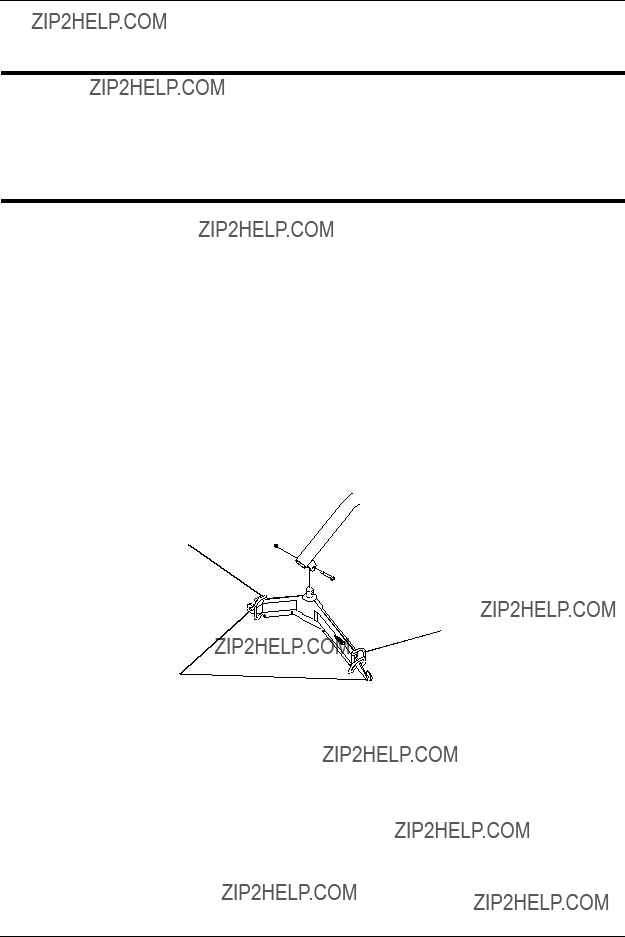
SECTION 8???LIFTING THE PATIENT
SECTION 8???LIFTING THE PATIENT
� WARNING
Before lifting or transferring the patient, the base legs MUST be locked in the open position for optimum stability and safety.
Refer to General Guidelines on page 10 before proceeding further and observe all WARNINGS indicated.
NOTE: For this procedure, refer to FIGURE 8.1, FIGURE 8.2, FIGURE 8.3, and FIGURE 8.4.
1.Using the steering handle, push the patient lift underneath the bed.
2.Lower the patient lift for easy attachment of the sling hardware or straps (FIGURE 8.1).
3.Do one of the following:
???Chains, O-Rings and D-Rings: After the chains, O-Rings or D-Rings are attached and the S-hooks are secured in both sides of the sling sections (open end facing outward), place the D-rings of the strap assembly or the O-ring and chain link of the chain assembly over the chain hooks of the swivel bar.
???Chain-Free All Fabric Slings: Attach the color-coded straps to the strap hooks of the swivel bar.
Strap Hooks
Strap Hooks
Chain Hooks 
FIGURE 8.1 Lifting the Patient
4.Pump the lift handle or turn the handle clockwise (clicking sound is normal) to raise the patient above the bed. The patient should be elevated high enough to clear the bed and their weight supported by the lift.
NOTE: The manual (crank) lift handle will automatically turn back one quarter turn to lock in place.
NOTE: On a hydraulic lift, the boom will stay in position until the control valve is opened.
5.When the patient is lifted from the bed (with the patient???s head supported), he/she will be raised to a sitting position (FIGURE 8.2).
SECTION 8???LIFTING THE PATIENT
FIGURE 8.2 Lifting the Patient
� WARNING
When elevated a few inches off the surface of the bed and before moving the patient, check again to make sure that all hardware is properly connected. Check each S-hook to make sure it is completely attached to the metal support bars of the sling. Check the attachment of the straps, O or D-rings to the swivel bar hooks. If any attachments are NOT properly in place, lower the patient back onto the bed and correct this problem.
Adjustments for safety and comfort should be made before moving the patient. Patient???s arms should be inside of the chains or straps.
Invacare slings and hardware are made specifically for use with Invacare Patient Lifts. For the safety of the patient, DO NOT intermix slings and patient lifts of dif- ferent manufacturers.
6. When patient is clear of the bed surface, swing their feet off the bed (FIGURE 8.3).
FIGURE 8.3 Lifting the Patient
SECTION 8???LIFTING THE PATIENT
7.Using the steering handles, move the patient lift away from the bed.
8.When moving the patient lift away from the bed, turn patient so that he/she faces assistant operating the patient lift (FIGURE 8.4).
9.Turn crank handle counterclockwise (manual) or open control valve (hydraulic) lowering patient so that his feet rest on or over the base of the lift, straddling the mast. Close control valve.
NOTE: The lower center of gravity provides stability making the patient feel more secure and the lift easier to pull or push.
10. Pull the patient lift away from the bed and push from behind with both hands.
FIGURE 8.4 Lifting the Patient

SECTION 9???BATHROOM
SECTION 9???BATHROOM
Transferring Patient for Use of Commode Chair or Standard Commode
Transferring to a Commode Chair
� WARNING
When elevated a few inches off the surface of the commode chair or standard commode and before moving the patient, check again to make sure that all hardware or straps are properly connected. Check each S-hook to make sure it is completely attached to the metal bars of the sling. Check the attachment of the straps, O or D-rings to the swivel bar hooks. If any attachments are NOT properly in place, lower the patient back onto the commode chair or standard commode to correct this problem.
Adjustments for safety and comfort should be made before moving the patient. Patient???s arms should be inside of the chains or straps.
Invacare slings and Hardware are made specifically for use with Invacare Patient Lifts. For the safety of the patient, DO NOT intermix slings and patient lifts of dif- ferent manufacturers.
NOTE: For this procedure, refer to FIGURE 9.1 on page 33.
NOTE: The slings with commode openings are designed to be used with either a commode chair or standard commode.
NOTE: Invacare recommends that the sling remain connected to the swivel bar during the patient???s use of either the commode chair or standard commode.
1.Elevate the patient high enough to clear the commode chair and their weight supported by the lift.
2.With the help of both assistants, guide the patient onto the commode chair.
3.Lower the patient onto the commode chair leaving the sling attached to the swivel bar.
4.When complete, recheck for correct attachment and then raise the patient off the commode chair.
5.When patient is clear of the commode surface (using the steering handles), move the lift away from the commode chair.
6.To return or place patient in a wheelchair. Refer to Transferring to a Wheelchair on page 35.

SECTION 9???BATHROOM
FIGURE 9.1 Transferring to a Commode Chair
Transferring to a Standard Commode
NOTE: For this procedure, refer to FIGURE 9.1.
NOTE: The patient MUST be transferred to a wheelchair and transported to the bathroom facilities before using the patient lift again to position the patient on a standard commode.
1.Move the patient from the bed to the wheelchair. Refer to Transferring to a Wheelchair on page 35.
2.Elevate the patient high enough to clear the standard commode and their weight supported by the patient lift.
3.With the help of both assistants, guide the patient onto the standard commode.
4.Lower the patient onto the standard commode leaving the sling attached to the swivel bar hooks.
5.When complete, recheck for correct attachment and then raise the patient off of the standard commode.
6.When patient is clear of the standard commode surface (using the steering handles), move the lift away from the standard commode.
7.To return or place a patient in a wheelchair, refer to Transferring to a Wheelchair on page 35.

SECTION 9???BATHROOM
Bathing
� WARNING
When elevated a few inches off the surface of the bed and before moving the patient, check again to make sure that all hardware or straps are properly connected. Check each S-hook to make sure it is completely attached to the metal support bars of the sling. Check the attachment of the straps, O or D-rings to the swivel bar hooks. If any attachments are NOT properly in place, lower the patient completely to correct this problem.
Adjustments for safety and comfort should be made before moving the patient. Patient's arms should be inside of the chains or straps.
Invacare slings and hardware are made specifically for use with Invacare Patient Lifts. For the safety of the patient, DO NOT intermix slings and patient lifts of dif- ferent manufacturers. Warranty will be voided.
NOTE: There are many portable bathing apparatuses. Refer to your particular portable bath instructions and use them in conjunction with this Owner???s Manual.
1.Remove the patient from the bed. Refer to Transferring to a Wheelchair on page 35.
2.Elevate the patient high enough to clear the commode chair and their weight supported by the lift.
3.Lower the patient into the portable bath tub.
4.Detach chains/straps from sling and reattach to the portable bath tub.
5.Using the lift, raise the sides of the portable bath tub.
6.Bathe the patient.
7.Reverse procedures to return the patient to the bed.

SECTION 10???TRANSFERRING
SECTION 10???TRANSFERRING
Transferring to a Wheelchair
� WARNING
When elevated a few inches off the seating surface of the wheelchair and before moving the patient, check again to make sure that all hardware and straps are properly connected. Check each S-hook to make sure it is completely attached to the metal support bars of the sling. Check the attachment of the straps, O or D- rings to the swivel bar hooks. If any attachments are NOT properly in place, lower the patient completely to correct this problem.
Adjustments for safety and comfort should be made before moving the patient. Patient???s arms should be inside of the chains or straps.
Invacare slings and Hardware are made specifically for use with Invacare Patient Lifts. For the safety of the patient, DO NOT intermix slings and patient lifts of dif- ferent manufacturers.
NOTE: For this procedure, refer to FIGURE 10.1 on page 36.
NOTE: Invacare recommends that two assistants be used when transferring a patient to a wheelchair.
1.Ensure the legs of the lift (w/patient) are in the opened position.
2.Move the wheelchair into position.
3.Lock the rear wheels to further prevent movement of the chair (Detail ???A??? of FIGURE 10.1).
� WARNING
Wheelchair wheel locks MUST be in a locked position before lowering the patient into the wheelchair for transport.
4.Position the patient over the seat with their back against the back of the chair (Detail ???B??? of FIGURE 10.1).
5.Lower the patient either by doing one of the following:
???Open the control valve.
???Turn the crank counterclockwise.
6.The assistant behind the chair pulls back on either the handle or sides of the sling to place the patient into the back of the chair. (Detail ???C??? of FIGURE 10.1).
NOTE: Holding the handle or sides of the patient lift maintains a good center of balance and prevent the chair from tipping forward
7. Disconnect the sling from the patient lift.

SECTION 10???TRANSFERRING
Transferring to a Car
� WARNING
When elevated a few inches off the seating surface of the wheelchair and before moving the patient, check again to make sure that all hardware or straps are properly connected. Check each S-hook to make sure it is completely attached to the metal support bars of the sling. Check the attachment of the straps, O or D-rings to the swivel bar hooks. If any attachments are not properly in place, lower the patient completely to correct this problem.
Adjustments for safety and comfort should be made before moving the patient. Patient???s arms should be inside of the chains or straps.
Invacare slings and hardware are made specifically for use with Invacare Patient Lifts. For the safety of the patient, DO NOT intermix slings and patient lifts of dif- ferent manufacturers.
NOTE: For this procedure, refer to FIGURE 10.2 on page 38.
NOTE: To position an individual in a sling, follow the procedures concerning lifting the patient, operation and sling attachments.
NOTE: Invacare recommends that two assistants be used when transferring a patient from a wheelchair to a car.
NOTE: The transfer to a car should be made on a level driveway or surface.
NOTE: Before lifting the patient from the chair, make sure to shorten the distance between the patient and the boom. This will make the transfer into the seat of the car easier.
NOTE: Assistants should practice ??Good Body Mechanics?? (use your legs) when positioning patient onto any seating surface.
1.Attach the chains or straps to swivel bar (Detail ???A??? of FIGURE 10.2).
2.Lock the rear wheels to further prevent movement of the chair (Detail ???B??? of FIGURE 10.2).
3.Lift the patient from the wheelchair (Detail ???C??? of FIGURE 10.2).
4.Move the lift, by the steering handles, to a position close to the doorway of the car.
5.Lower the boom of the lift until it is about even with the roof of the car.
6.As one assistant pushes the patient into the car by his knees until he/she is positioned over the seat of the car, the other assistant lowers the boom.
7.As the boom is being lowered, the first assistant is not only pushing but turning the patient so he/she is positioned facing the front of the car (Detail ???D??? of FIGURE 10.2).
NOTE: The patient will come to rest on the seat of the car.
8.While one assistant is holding the patient, the other assistant removes the chains or straps from the swivel bar and slides the patient lift out of the way (Detail ???E??? of FIGURE 10.2).
NOTE: The sling may be left under the patient or removed (Detail ???F??? of FIGURE 10.2).
SECTION 10???TRANSFERRING
9.If necessary, remove the mast, boom and pump assembly from the base and transport them in the car.
NOTE: If the lift and wheelchair are both packed in the trunk of the car, care should be taken not to damage the spokes of the wheelchair on the steering handles of the lift.
FIGURE 10.2 Transferring to a Car

SECTION 10???TRANSFERRING
Transferring from a Car to a Wheelchair
� WARNING
When elevated a few inches off the seat of the car and before moving the patient, check again to make sure that all hardware or straps are properly connected. Check each S-hook to make sure it is completely attached to the metal support bars of the sling. Check the attachment of the straps, O or D-rings to the swivel bar hooks. If any attachments are NOT properly in place, lower the patient completely to correct this problem.
Adjustments for safety and comfort should be made before moving the patient. Patient???s arms should be inside of the chains or straps.
Invacare slings and hardware are made specifically for use with Invacare Patient Lifts. For the safety of the patient, DO NOT intermix slings and patient lifts of dif- ferent manufacturers. Warranty will be voided.
NOTE: For this procedure, refer to FIGURE 10.3 on page 40.
NOTE: Invacare recommends that two assistants be used when transferring a patient from a car to a wheelchair.
NOTE: One assistant MUST support patient at all times.
1.With the first assistant supporting the patient, the second assistant lowers the boom of the patient lift until the hooks of the swivel bar are even with the roof of the car.
2.Attach the sling to the swivel bar (Detail ???A??? of FIGURE 10.3).
3.Lift the patient up off of seat until straps are taut.
4.Turn patient with sling until legs are outside of car.
NOTE: assistants should practice ??Good Body Mechanics?? (use your legs) when positioning patient onto any seating surface.
5.Lift up on legs with one hand and tilt the patient back with the other hand.
6.The second assistant should pull the patient lift away from the car until the patient is completely clear of the door frame (Detail ???B??? of FIGURE 10.3).
7.Release the patient back to his/her normal sitting position in the sling.
8.Place patient in wheelchair. Refer to Transferring to a Wheelchair on page 35.

SECTION 11???CARE AND MAINTENANCE
SECTION 11???CARE AND
MAINTENANCE
NOTE: Follow the maintenance procedures described in this manual to keep your patient lift in continuous service.
The Invacare Patient Lift is designed to provide a maximum of safe, efficient and satisfactory service with minimum care and maintenance.
All parts of the Invacare Lift are made of the best grades of steel, but metal to metal contact will wear after considerable use.
There is no adjustment or maintenance the casters, other than cleaning, lubrication and checking axle and swivel bolts for tightness. Remove all debris, etc. from the wheel and swivel bearings. If any parts are worn, replace these parts IMMEDIATELY.
If you question the safety of any part of the lift, contact your Dealer IMMEDIATELY and advise him/her of your problem.
Hydraulic Pump
All parts of the Hydraulic Pump are precision machined, then carefully assembled and tested to ensure reliable service. The pump assembly is completely enclosed and sealed with Neoprene rings to prevent leakage of hydraulic oil. A small amount of oil (about a drop) will accumulate around the piston from time to time and should be removed with a facial tissue.
� WARNING
The hydraulic pump is sealed at the factory and if service is required, the pump unit MUST be returned to the factory for repair. DO NOT attempt to open the hydrau- lic pump or obtain local service. This will void the warranty and might result in dam- age and costly repair. Consult your Dealer or write Invacare for information.
Lubrication
The Invacare lift is designed for minimum maintenance; however, a six month check and lubrication should ensure continued safety and reliability.
Keep lift and slings clean and in good working order. Any defect should be noted and reported to your dealer as soon as possible.
The casters MUST swivel and roll smoothly. A light grease (waterproof auto lubricant) may be applied to the ball bearing swivel of the casters once a year. Apply grease more frequently if the casters are exposed to extreme moist conditions.
The connection between the mast and the base should be cleaned and coated with petroleum jelly prior to assembly.

SECTION 11???CARE AND MAINTENANCE
Lubricate all pivot points. Wipe all excess lubricant from lift surface.
1.Swivel Bar at Mounting Bracket
2.Boom Mounting Bracket
3.Boom to Mast Mount
4.Mast Mounting Bracket
5.Base to Mast Mount
6.Rear Casters
7.Front Casters
Wear and Damage
It is important to inspect all stressed parts, such as slings, spreader bar and any pivot for slings for signs of cracking, fraying, deformation or deterioration. Replace any defective parts IMMEDIATELY and ensure that the lift is not used until repairs are made.
All sling metal parts should be inspected every three months, and if wear is apparent, replacement must be made.
Check that all labels are present and legible. Replace if necessary.
Cleaning
The sling should be washed regularly in hot water (maximum temperature of 180??F (82??C)) and a biological solution. A soft cloth, dampened with water and a small amount of mild detergent, is all that is needed to clean the patient lift. The lift can be cleaned with non-abrasive cleaners. Auto wax or furniture polish will help maintain the sparkling finish over a long period of time.
Ensure that casters are free of debris.
SECTION 11???CARE AND MAINTENANCE
Maintenance Safety Inspection Checklist
*NOTE: For individual home use, a full inspection is required prior to each new user.
**NOTE: Regular cleaning will reveal loose or worn parts, enhance smooth operation and extend life expectancy of the lift.
LIMITED WARRANTY
PLEASE NOTE: THE WARRANTY BELOW HAS BEEN DRAFTED TO COMPLY WITH
FEDERAL LAW APPLICABLE TO PRODUCTS MANUFACTURED AFTER JULY 4, 1975. This warranty is extended only to the original purchaser/user of our products.
This warranty gives you specific legal rights and you may also have other legal rights which vary from state to state.
Invacare warrants the products manufactured to be free from defects in materials and workmanship for a period of three years on the lift and one year on the slings, hydraulic pump / electric components from the date of purchase. If within such warranty period any such product shall be proven to be defective, such product shall be repaired or replaced, at Invacare???s option. This warranty does not include any labor or shipping charges incurred in replacement part installation or repair of any such product. Invacare???s sole obligation and your exclusive remedy under this warranty shall be limited to such repair and/or replacement.
For warranty service, please contact the dealer from whom you purchased your Invacare product. In the event you do not receive satisfactory warranty service, please write directly to Invacare at the address on the back cover, provide dealer???s name, address, date of purchase, indicate nature of the defect.
Invacare Corporation will issue a serialized return authorization. The defective unit or parts MUST be returned for warranty inspection using the serial number, when applicable as identification within 30 days of return authorization date. Do not return products to our factory without our prior consent. C.O.D. shipments will be refused; please prepay shipping charges.
LIMITATIONS AND EXCLUSIONS: THE FOREGOING WARRANTY SHALL NOT APPLY
TO SERIAL NUMBERED PRODUCTS IF THE SERIAL NUMBER HAS BEEN REMOVED OR
DEFACED, PRODUCTS SUBJECTED TO NEGLIGENCE, ACCIDENT, IMPROPER
OPERATION, MAINTENANCE OR STORAGE, PRODUCTS MODIFIED WITHOUT
INVACARE???S EXPRESS WRITTEN CONSENT (INCLUDING, BUT NOT LIMITED TO,
MODIFICATION THROUGH THE USE OF UNAUTHORIZED PARTS OR ATTACHMENTS;
PRODUCTS DAMAGED BY REASON OF REPAIRS MADE TO ANY COMPONENT
WITHOUT THE SPECIFIC CONSENT OF INVACARE, OR TO A PRODUCT DAMAGED BY
CIRCUMSTANCES BEYOND INVACARE???S CONTROL, AND SUCH EVALUATION WILL
BE SOLELY DETERMINED BY INVACARE. THE WARRANTY SHALL NOT APPLY TO
PROBLEMS ARISING FROM NORMAL WEAR OR FAILURE TO ADHERE TO THE
INSTRUCTIONS IN THIS MANUAL.
THE FOREGOING WARRANTY IS EXCLUSIVE AND IN LIEU OF ANY OTHER EXPRESS
WARRANTIES. IMPLIED WARRANTIES, IF ANY, INCLUDING THE IMPLIED
WARRANTIES OF MERCHANTABILITY AND FITNESS FOR A PARTICULAR PURPOSE,
SHALL NOT EXTEND BEYOND THE DURATION OF THE EXPRESSED WARRANTY
PROVIDED HEREIN AND THE REMEDY FOR VIOLATIONS OF ANY IMPLIED WARRANTY
SHALL BE LIMITED TO REPAIR OR REPLACEMENT OF THE DEFECTIVE PRODUCT
PURSUANT TO THE TERMS CONTAINED HEREIN. INVACARE SHALL NOT BE LIABLE
FOR ANY CONSEQUENTIAL OR INCIDENTAL DAMAGES WHATSOEVER.
SOME STATES DO NOT ALLOW EXCLUSION OR LIMITATION OF INCIDENTAL OR
CONSEQUENTIAL DAMAGE, OR LIMITATION ON HOW LONG AN IMPLIED WARRANTY
LASTS, SO THE ABOVE EXCLUSIONS AND LIMITATIONS MAY NOT APPLY TO YOU.
THIS WARRANTY SHALL BE EXTENDED TO COMPLY WITH STATE OR PROVINCIAL
LAWS AND REQUIREMENTS.
Part No 1024492
Rev E - 05/23/06







 WARNING
WARNING







 Angle Swivel Bar
Angle Swivel Bar (Ref.)
(Ref.) Tape Hex Key Here
Tape Hex Key Here



 Assembly
Assembly


 of Sling
of Sling assistant and Bed Surface)
assistant and Bed Surface)







 End Away From
End Away From Buckles
Buckles
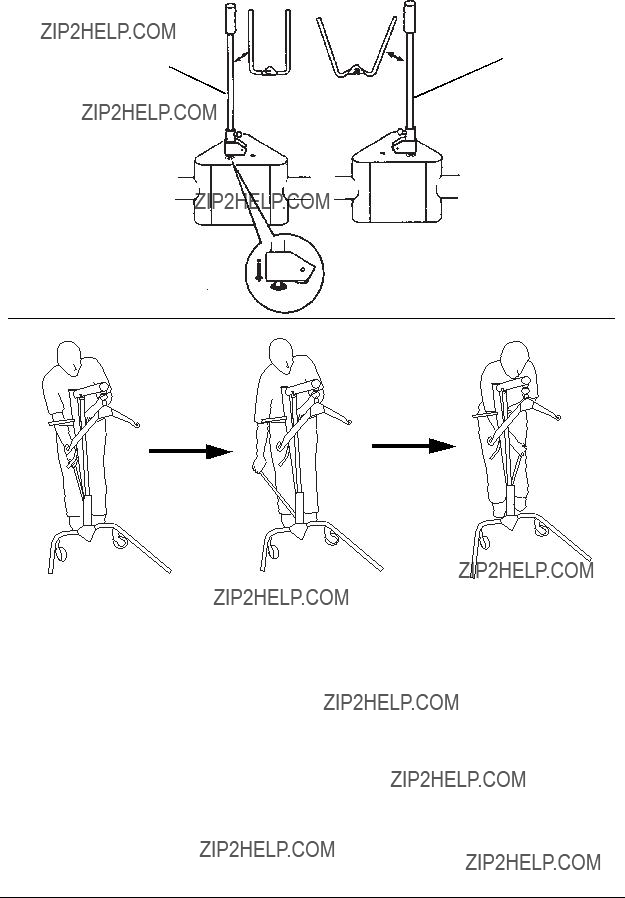




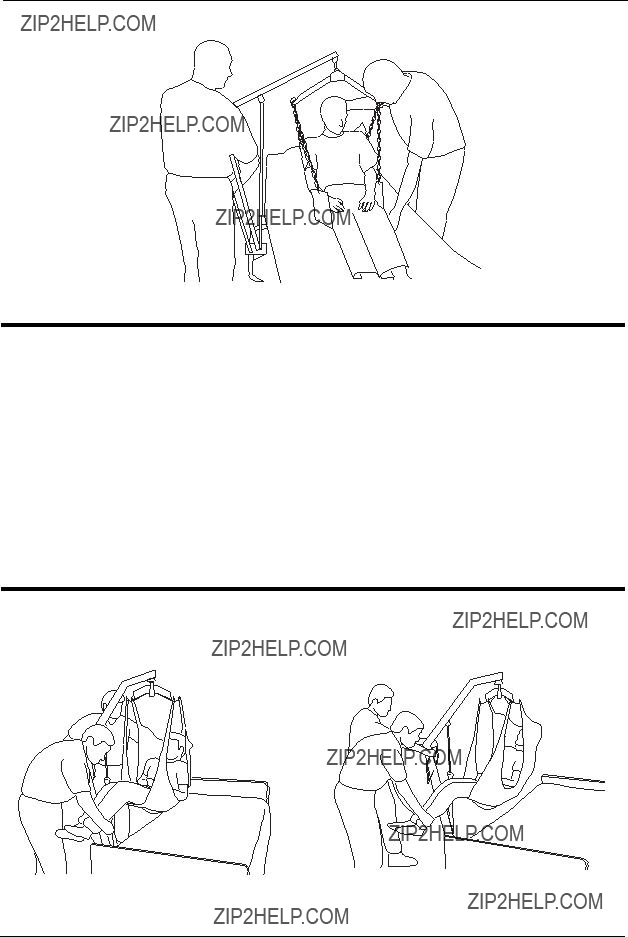
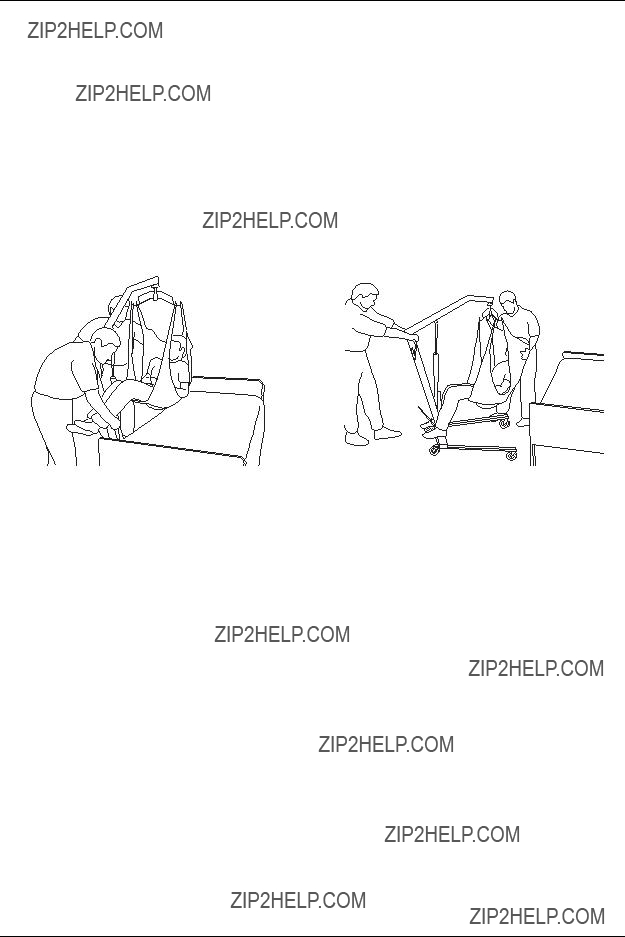










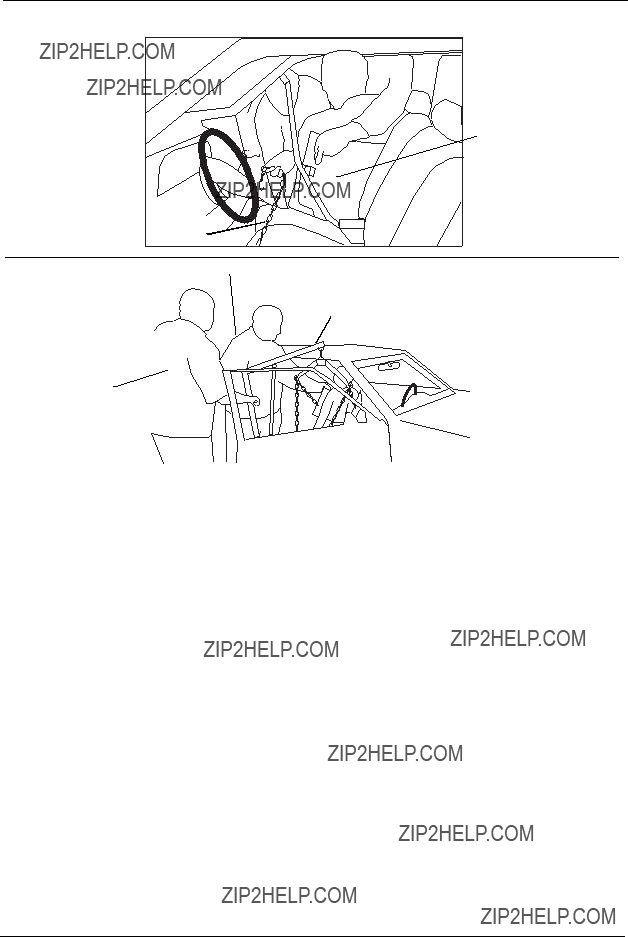
 Sling
Sling


